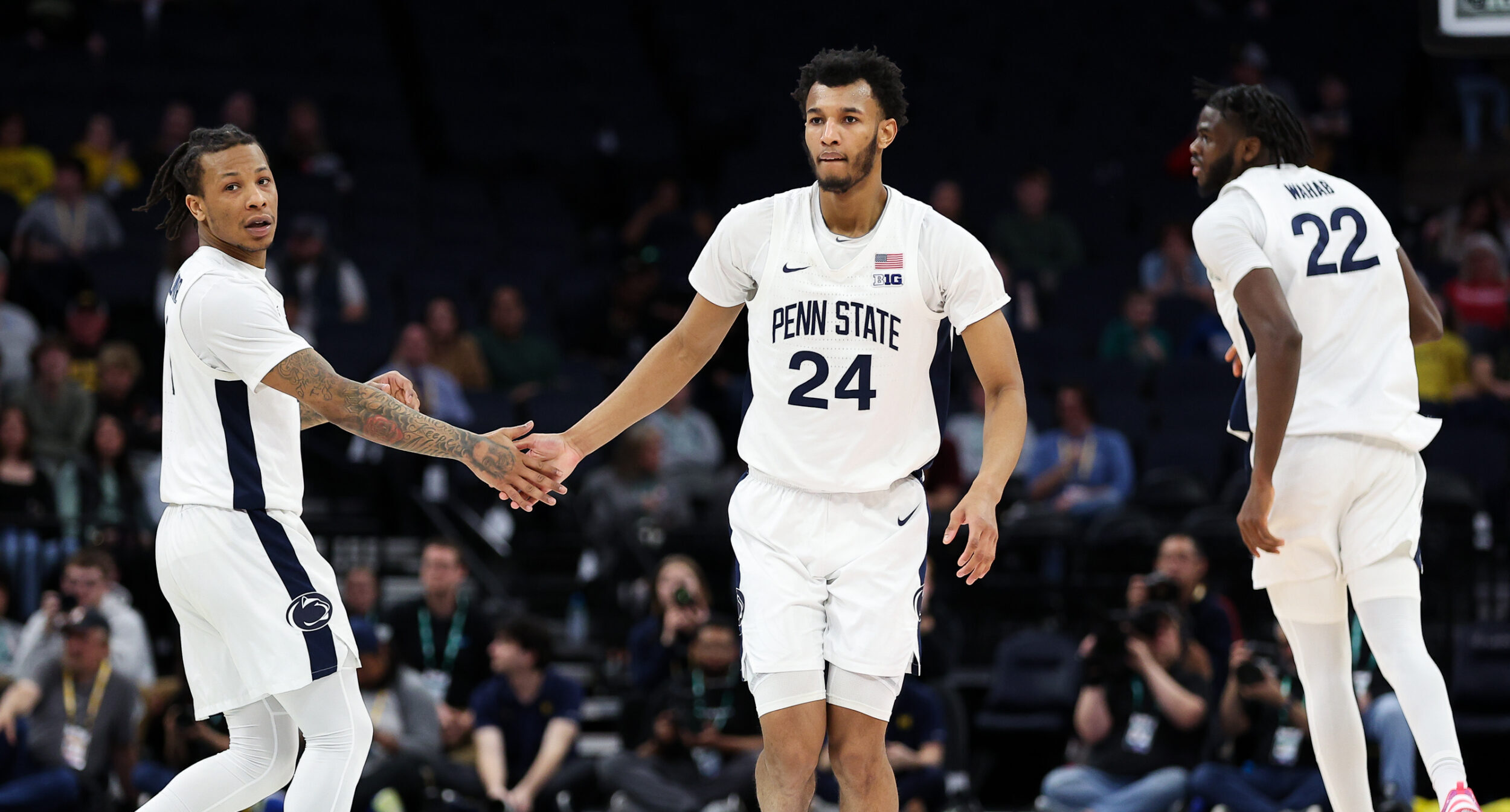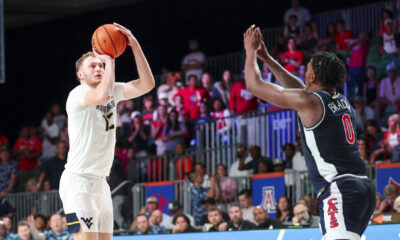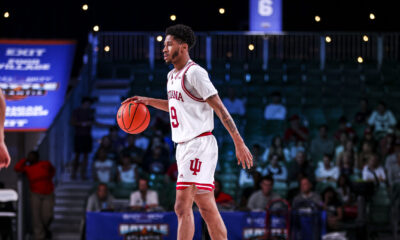BASKETBALL
Scouting Notes: Penn State
Published
1 year agoon

The Indiana basketball program begins its postseason play with a matchup against Penn State in the Big Ten Tournament on Thursday night.
The Nittany Lions beat Michigan in the opening night of the Big Ten Tournament, 66-57.
Penn State swept the season-series this season against Indiana. The Nittany Lions come in ranked 79th in offensive efficiency with a rating of 112.5. Defensively, it is ranked 89th with a rating of 102. Overall, Penn State is ranked 77th in the KenPom ratings.
Here is a deep dive into some of the challenges Penn State could give the Indiana basketball program.
Key Players
Penn State leans heavily on point guard Ace Baldwin — a very dynamic playmaker. Baldwin is a quick lefty guard who is a terrific passer and sets the tone offensively in terms of pacing and leadership. Baldwin is averaging 6.0 assists per game, ranking third in the Big Ten in assists and fourth in assist percentage. Baldwin does a great job of passing his teammates open and finding the open lanes through opposing defenses. He can also score. Despite being a streaky shooter for the first half of the year, he’s turned it to another gear over the last two months. In the last 15 games, Baldwin is shooting 45.2 percent from three on 1.9 made 3s a game. Though he’s shooting at a high clip from three, his game starts as a driver. Baldwin typically tries to get into the paint and score at the rim, Where Baldwin is at his best is in the open floor. Defensively, he sets the tone. He averages 2.7 steals per game — fifth nationally — and leads the Big Ten in steal percentage. Baldwin was named the Big Ten Defensive Player of the Year. He is terrific as an on ball or off ball defender, so the Indiana basketball ball handlers need to keep live ball turnovers to a minimum.
In the front court is Zach Hicks, someone who has been stepping up big for the Nittany Lions. After just five double-figure scoring games in the first 21 gams of the season, he’s scored in double figures in eight of the last 11 games, including four games of at least 15 points. He is averaging 12.3 points while shooting 41.1 percent from three over the last 11 games, compared to 6.2 points and 29.3 percent from three over the first 21 games of the season. Hicks is strictly a perimeter player, however. 74.4 percent of his shot attempts are 3s. Hicks has good size but is mainly just a big shooting wing at this point. Hicks isn’t going to actively look to attack off of the dribble. Indiana needs to be aware of him on all dribble-drive action and make sure he doesn’t get hot from three.
Qudus Wahab headlines the front court players, however. Wahab is a physical center who has great size and length. He’s most effective right at the rim offensively, however, with very little range outside of about 10 feet. He’s best as a roller on pick and roll sets and on offensive rebound put backs. Wahab ranks fourth in the Big Ten in offensive rebound percentage and also averages 2.7 offensive rebounds per game. In the last six games, Wahab is averaging 14.2 points and 8.5 rebounds a game while shooting 57.9 percent from the floor. He has six-straight double-digit scoring games. Defensively, Wahab ranks eighth in block percentage and is a really effective rim protector. Because of his frame, he pushes opposing big men off of their spots and forces a typical layup into more of a hook shot.
Nicholas Kern is a versatile forward who is extremely athletic and can score in a variety of ways at the rim. Kern sees almost all of his action inside the paint and uses his jumping ability and his length to finish at the rim and above defenders. Kern is not a threat from the perimeter, with just six made threes in 97 career games. When he’s attacking the rim, he’s looking to dunk the ball. But, most of his action is off of the ball, with little impact off of the dribble. Indiana basketball needs to keep an eye on him as he’s a very good cutter. Kern’s length allows him to switch on multiple ball handlers defensively. He’s averaging 11.4 points over the last nine games.
D’Marco Dunn has been put in the starting lineup over the last month for the Nittany Lions. The North Carolina transfer has been a really effective two-way player for the Nittany Lions. At 6-foot-4 and 185 pounds, he has great size and frame on both ends of the floor. Dunn can play both on and off the ball and has 11 double-digit scoring games this year. He’s shooting 36.3 percent from three this year but if a capable shooter if open. He’s made at least one three in seven straight games. Most of his jumpers are going to come off of the catch or in late shot clock situations. If he has the ball in his hands, he’s typically looking to attack — with his drives likely coming from the wing. He’s struggled with foul trouble over the last four games, however.
Puff Johnson is another UNC transfer who plays a significant role for Penn State. Johnson is a hybrid forward who likes to play bigger than he is — frame wise. Johnson will likely play a lot of small-ball four but is more impactful making high-energy plays. He has always had the ability to be a three-point threat but has been streaky. He’s shooting 34.8 percent from three on the year. Johnson has been his best over the last five games, averaging 11.2 points and shooting 61.5 percent from three on 1.6 makes per game.
Another part of the rotation is guard Jameel Brown. After going scoreless in 10 of the first 15 games of the season, he’s become a threat from the outside, albeit very streaky and inconsistent. He has eight games of 7+ points but also 13 games with zero points. He’s a long, athletic guard who is going to be strictly a perimeter player. 90 of his 106 field goal attempts this year have been 3s. He had four 3s against Indiana in the first matchup and went 0-of-5 in the second. He is o-of-11 from three in the last five games.
Indiana Basketball: 3 keys to a deep Big Ten Tournament run
Key Tendencies
Offensively, Penn State runs through its backcourt every possession. It’s clear Ace Baldwin is the motor of the team — both scoring and playmaking. Because of his quickness, Penn State likes to get out in transition. Despite the uptempo pace for Penn State, it’s not a team that will turn the ball over on a large scale — averaging just 11 turnovers per game. Penn State has five players attempting 2.4 3s or more per game but as a team, and four players shooting at least 34 percent so it will have a lot of 4-perimeter player sets to spread the floor. As a team it converts on just 33.6 percent — ranked 206th. In the last six games, however, it is shooting 38.8 percent on 7.5 made 3s a game. In two games against Indiana, Penn State hit 21 3s. Regardless of who’s in the backcourt for Indiana basketball, they need to force the guards out of the paint and limit their driving ability.
Penn State is a high-pressure defense and is one of the best in the country in forcing turnovers. On the season, the Nittany Lions rank 17th in the country in forced turnovers per game and also do an even better job at converting off of turnovers. They force 14.8 turnovers per game. The ball pressure from its perimeter players force a lot of live ball turnovers, ranking 30th nationally in steal rate and 24th in turnover rate. While there isn’t a great amount of rim protection behind them, Qudus Wahab does a suitable job at forcing difficult shots at the rim. Indiana needs to do a good job at getting the ball in the paint and feeding the big men. Penn State doesn’t have the front court talent or depth to match up with Indiana basketball. Because of that, the foul rate for Penn State ranks 13th in the Big Ten, allowing opponents to get to the line 20.9 times per game. Indiana will have opportunities to shoot 3s but opponents are shooting just 29.2 percent from three in the last six games.
Overall, this is a game that Indiana has more overall talent in, but it’ll be a matter of if it has the mental toughness to withstand the gritty play of Penn State, much like the first two matchups. Indiana needs to offset the backcourt advantage for the Nittany Lions with doing what it does best — protecting the paint and scoring in the paint. Indiana basketball should be able to win the rebound battle, especially offensively with Penn State giving up nearly 11 offensive rebounds per game and ranked 13th in the Big Ten in offensive rebound rate from a defensive perspective. This game could come down to the play of Xavier Johnson — who didn’t play in either of the matchups in the regular season. He adds speed to match that of Ace Baldwin, but if he’s sloppy with the ball, it’ll give Penn State’s turnover-heavy defense even more of an advantage.
Projected Starters
G – Ace Baldwin (Senior; 6-0, 190)
Stats: 14.3 ppg, 6.0 apg, 2.7 spg, 34.5% 3pt
G – D’Marco Dunn (Junior; 6-5, 185)
Stats: 6.8 ppg, 1.8 rpg, 36.3% 3pt
F – Zach Hicks (Junior; 6-7, 185)
Stats: 8.3 ppg, 3.9 rpg, 33.9% 3pt
F – Nicholas Kern (Junior; 6-6, 190)
Stats: 8.7 ppg, 4.0 rpg
C – Qudus Wahab (Senior; 6-11, 240)
Stats: 9.9 ppg, 7.8 rpg, 1.5 bpg
Key Notes
- Penn State swept the Hoosiers for the first time since 2009
- Penn State is averaging 75.6 points per game — which would be the highest in program history since 2000-01
- Opponents are shooting just 25.8 percent from three in Penn State’s 16 wins vs 35.1 percent in Penn State’s 16 losses
- Penn State leads the Big Ten in steals and ranks second in turnovers forced per game and turnover margin
SEE ALSO: ‘We’re playing as good as any team in the country right now’: Indiana basketball enters Big Ten Tournament with extreme confidence as season hangs in the balance
Make sure to follow Hoosier Illustrated, part of the Full Ride Network, on Twitter @Indiana_FRN, Facebook and YouTube to stay up to date on all of the news, updates and coverage of Indiana University athletics. You can also listen to the Talking’ Bout the Hoosiers podcast on Spotify.
Looking for a place to get more Indiana content? Hoosier Illustrated has partnered with Tom Brady’s company ‘Autograph’ to streamline our coverage, so you can continue to do what you do best – follow IU sports. Use the CODE: Indianafr to get started today. For more info, you can start here.
Alec Lasley is the owner of Hoosier Illustrated, a comprehensive site covering news, updates and recruiting for Indiana University athletics. Alec has covered Indiana for six years and is a credentialed media member. He has previously worked for both Rivals and 247Sports.

You may like
-


In Touch with Indiana Sports Ep.101 — Indiana basketball transfer portal targets, Fernando Mendoza fitting in with IU football, the 2025 Final Four is set, and more
-


Indiana basketball extends offer to 2027 prospect
-


In Touch with Indiana Sports Ep.100 — Indiana basketball & the transfer portal, Hoosiers eligible for offseason foreign trip, IU football’s projected win total, and more
-


‘It’s great for college basketball’: Mark Pope back in Indianapolis and excited about renewal of IU basketball and Kentucky series
-


Where expected Indiana basketball transfer Tucker DeVries lands in early transfer portal rankings
-


Indiana basketball guard Kanaan Carlyle leaving program and entering the transfer portal
